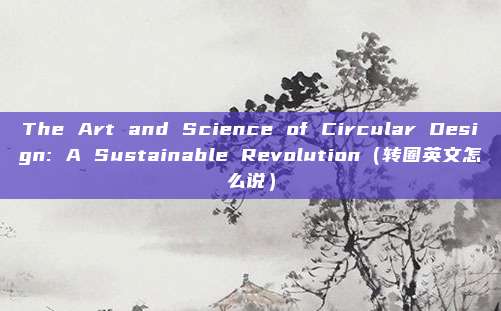The Art and Science of Circular Design: A Sustainable Revolution(转圈英文怎么说)
温馨提示:这篇文章已超过238天没有更新,请注意相关的内容是否还可用!
Introduction
In an era where sustainability and environmental consciousness are at the forefront of global discourse, the concept of circular design has emerged as a beacon of hope. This innovative approach to product development and manufacturing aims to eliminate waste and extend the life cycle of products. This article delves into the essence of circular design, its benefits, and how it's reshaping industries worldwide.
The Concept of Circular Design
Circular design, as the name suggests, revolves around the idea of creating products that are designed to be continuously reused, repaired, remanufactured, and recycled. Unlike the traditional linear model of 'take, make, dispose,' circular design encourages a closed-loop system where resources are conserved and materials are kept in use for as long as possible.

The Circular Economy
The concept of a circular economy is closely tied to circular design. It's an economic model that aims to eliminate waste through the elimination of the concept of 'waste' and the substitution of materials that are renewable and recyclable. According to the Ellen MacArthur Foundation, a circular economy could create $1 trillion in business value by 2030.
Benefits of Circular Design
The adoption of circular design offers numerous benefits, both environmentally and economically. Here are some key advantages:
Environmental Impact
Reduced Emissions: By extending the life of products and materials, circular design helps reduce the carbon footprint associated with manufacturing new products.
Resource Efficiency: The use of recycled and renewable materials minimizes the extraction of new resources, thus conserving natural ecosystems.
Waste Reduction: The closed-loop system minimizes waste, which is a significant environmental concern.
Economic Benefits
Cost Savings: By reducing the need for new materials and minimizing waste, businesses can save on production costs.
New Business Opportunities: Circular design can open up new markets and business models, such as product-as-a-service (PaaS) models.
Innovation: The push for sustainable solutions can drive innovation and lead to the development of new technologies and products.
Case Studies: Successful Implementations of Circular Design
Several industries have already started to embrace circular design, and some notable examples include:
Furniture Industry
IKEA, the world's largest furniture retailer, has made significant strides in circular design. The company has introduced products that are easier to disassemble and recycle, and it encourages customers to return used furniture for recycling.
Fashion Industry
Patagonia, an outdoor clothing brand, has taken a stand for circular design by using recycled materials in its products and encouraging customers to buy second-hand Patagonia gear through its Worn Wear program.
Automotive Industry
Tesla, the electric vehicle manufacturer, has designed its vehicles with circularity in mind. The company aims to use the same battery packs for multiple vehicles throughout their lifetime, reducing the need for new materials.
Challenges and Solutions
Despite the numerous benefits, circular design faces several challenges:
Technological Barriers
Recycling Processes: The development of efficient and cost-effective recycling processes for certain materials is still in its infancy.
Design Complexity: Designing products that are easy to disassemble and recycle can be more complex and expensive.
Consumer Behavior
Awareness: Many consumers are not yet aware of the benefits of circular design.
Waste Disposal: Encouraging consumers to return products for recycling can be difficult.
To overcome these challenges, stakeholders across the supply chain need to collaborate and invest in research and development. Governments and regulatory bodies can also play a crucial role by creating policies that incentivize circular design practices.
Conclusion
Circular design is not just a trend; it's a transformative approach that has the potential to revolutionize how we produce, consume, and dispose of products. By embracing circularity, businesses can create sustainable value, reduce their environmental impact, and drive innovation. As we move towards a more sustainable future, circular design will undoubtedly play a pivotal role in shaping the world we live in.
网站文章、图片来源于网络,以不营利的目的分享经验知识,版权归原作者所有。如有侵权请联系删除!





还没有评论,来说两句吧...